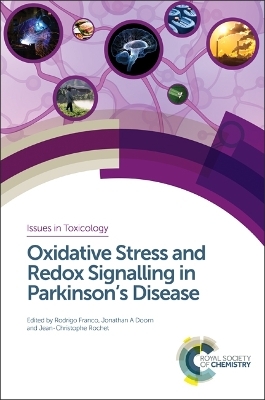
Oxidative Stress and Redox Signalling in Parkinson’s Disease
Royal Society of Chemistry (Verlag)
978-1-78262-188-1 (ISBN)
Parkinson's Disease is the second most common neurodegenerative disorder affecting millions of people worldwide. In order to find neuroprotective strategies, a clear understanding of the mechanisms involved in the dopaminergic death of cells that progresses the disease is needed. Oxidative stress can be defined as an imbalance between the production of reactive species and the ability to detoxify them and their intermediates or by-products. Oxidative damage to lipids, proteins, and DNA has been detected in autopsies from individuals with Parkinson’s Disease and so links can be made between oxidative stress and Parkinson’s Disease pathogenesis.
This book provides a thorough review of the mechanisms by which oxidative stress and redox signalling mediate Parkinson’s Disease. Opening chapters bring readers up to speed on basic knowledge regarding oxidative stress and redox signalling, Parkinson’s Disease, and neurodegeneration before the latest advances in this field are explored in detail. Topics covered in the following chapters include the role of mitochondria, dopamine metabolism, metal homeostasis, inflammation, DNA-damage and thiol-signalling. The role of genetics and gene-environment interactions are also explored before final chapters discuss the identification of potential biomarkers for diagnosis and disease progression and the future of redox/antioxidant based therapeutics.
Written by recognized experts in the field, this book will be a valuable source of information for postgraduate students and academics, clinicians, toxicologists and risk assessment groups. Importantly, it presents the current research that might later lead to redox or antioxidant – based therapeutics for Parkinson’s disease.
Dr Franco is an Assistant Professor of Neuroscience at the Redox Biology Center, University of Nebraska-Lincoln. Prior to this position, he was post-doctoral fellow at the National Institute of Environmental Health Sciences, USA. His research interests include the role of oxidative stress and redox signaling in the regulation of cell death pathways, and in neuronal cell death associated with neurological disorders. He has been awarded the Layman Award and the SIGMA XI Outstanding Young Scientist Award. Dr Doorn is an Associate Professor of Medicinal and Natural Products Chemistry at the University of Iowa, College of Pharmacy. Before this, he was a post-doctoral fellow at the University of Colorado Health Sciences Center, Depts. of Pharmaceutical Sciences and Pharmacology, USA. His postdoctoral work involved studying the role of lipid peroxidation products and protein carbonylation in alcoholic liver disease. Dr Doorn received his Ph.D. from the University of Michigan, School of Public Health, Toxicology Program. Dr Rochet is an associate professor in the Department of Medicinal Chemistry and Molecular Pharmacology (College of Pharmacy) at Purdue University. Before his arrival at Purdue, Dr Rochet received his PhD degree at the University of Alberta in Biochemistry in 1998 and then worked as a post-doctoral fellow studying mechanisms of alpha-synuclein self-assembly in Parkinson’s disease in the laboratory of Dr. Peter Lansbury at Harvard Medical School. Dr.Rochet’s research group has a long-standing interest in Parkinson’s disease.
Parkinson’s Disease: Pathogenesis and Etiology;
Oxidative Stress and Redox Signalling in the Parkinsonian Brain;
Mitochondrial Dysfunction in Parkinson’s Disease;
Catecholamine Metabolism and the Generation of Reactive Aldehydes;
Dopamine Oxidation and Parkinson's Disease;
GSH and Thiol Redox Signalling;
Nitric Oxide Signalling and Inflammation in Parkinson’s Disease;
Redox Signalling and Dopaminergic Cell Death/Survival;
Iron Metabolism and Parkinson's Disease; Protein Oxidation, Quality Control and Degradation Pathways;
At the Intersection between Mitochondrial Dysfunction and Lysosomal Autophagy;
Genes, Environment and Aging;
Biomarkers of Oxidative Stress;
Dietary Factors in Parkinson’s Disease;
Antioxidants and Redox-basedTherapeutics
| Erscheint lt. Verlag | 25.7.2017 |
|---|---|
| Reihe/Serie | Issues in Toxicology ; Volume 34 |
| Verlagsort | Cambridge |
| Sprache | englisch |
| Maße | 156 x 234 mm |
| Gewicht | 968 g |
| Themenwelt | Studium ► 2. Studienabschnitt (Klinik) ► Pharmakologie / Toxikologie |
| Naturwissenschaften ► Biologie ► Biochemie | |
| ISBN-10 | 1-78262-188-1 / 1782621881 |
| ISBN-13 | 978-1-78262-188-1 / 9781782621881 |
| Zustand | Neuware |
| Haben Sie eine Frage zum Produkt? |
aus dem Bereich


